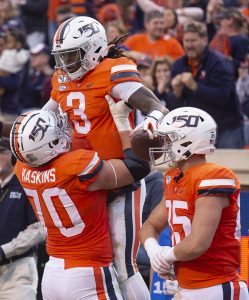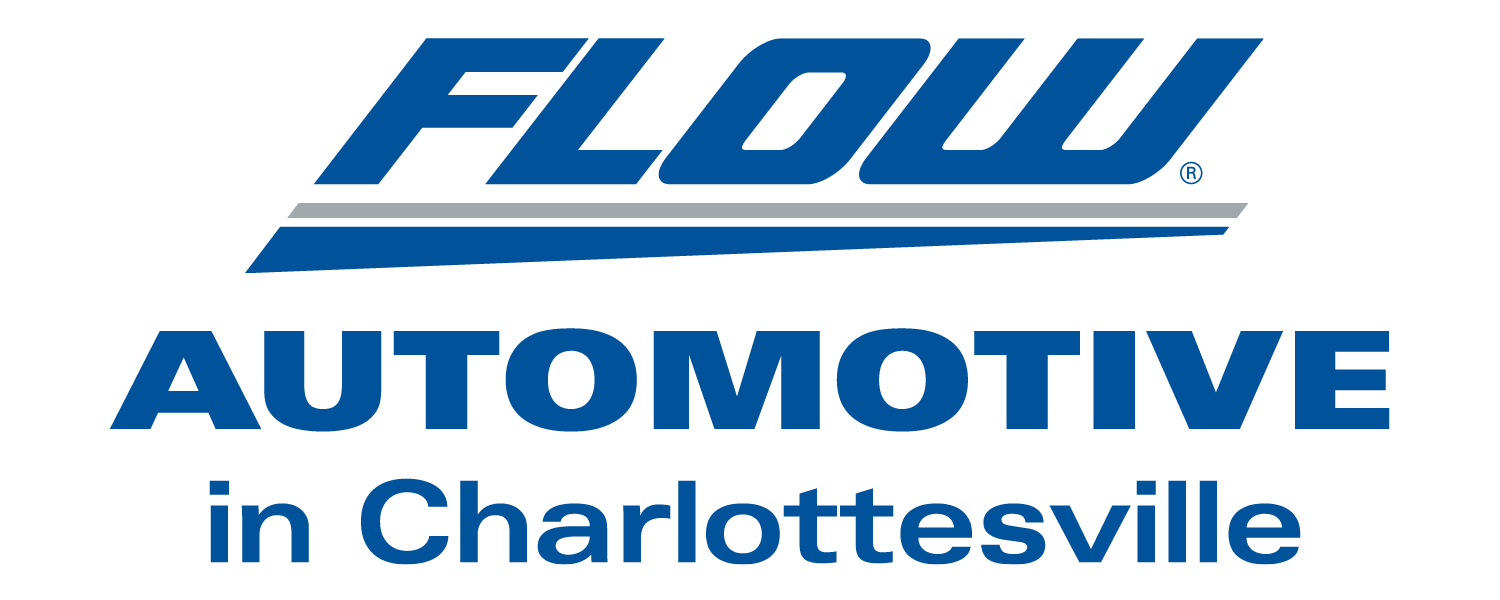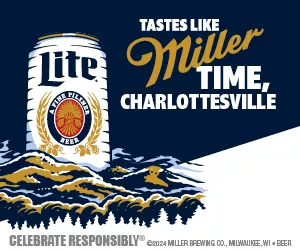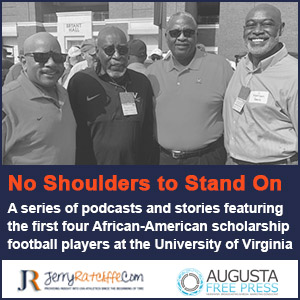Virginia Fixes Offensive Problem
By Jerry Ratcliffe

UVA lineman Bobby Haskins (70) gives Bryce Perkins a lift after Perkins’ third rushing TD (Photo by John Markon).
Fresh off a convincing 48-14 bounceback win over Duke, Bryce Perkins sat in the corner of the postgame interview room, dreadlocks partially covered by a bandana, as he began to hold court.
The Virginia quarterback seems to like talking to media and is good at it, so he always seems comfortable with the task — win or lose — whether he plays great or not so much. Saturday, he played more like his early-season self, which makes the Cavaliers very difficult to beat.
On a day when he personally accounted for 203 total yards and three touchdowns, nowhere near his career highs, Perkins was still extremely effective, and thusly so was Virginia’s offense.
“We got our swagger back,” Perkins beamed.
Ever since halftime at Notre Dame, UVA’s offense had been missing in action. It went seven consecutive quarters without a touchdown, and at Miami alone the Cavaliers struggled mightily in the “red zone,” with six trips inside it and a mere three field goals to show for their effort. As a result, Perkins and his teammates suffered back-to-back losses after a 4-0 start to the season.
Beating Duke was welcome relief, but even more so was the fact that UVA managed to put up 48 points, the most against an ACC team since 2007 when Al Groh’s Cavaliers stunned Miami 48-0 in the last game played at the old Orange Bowl stadium.
“We found our rhythm and pushed it forward,” Perkins said, acknowledging that Virginia’s defense getting five takeaways gave the offense a lot of short fields to work with. “Back-to-back losses was the greatest motivator for our team. Man, it sucked, especially coming off losing to Notre Dame and having a bye week, then go to Miami and lose. It made the whole week suck last week. The first thing you want to do was get back on the field and erase that whole thing and get a win and protect our house.”
Entering the Duke game as a five-point favorite, the Cavaliers enjoyed an offensive explosion. There were a few reasons why.
Perkins benefitted from his backup, redshirt freshman Brennan Armstrong, returning to the depth chart. UVA coach Bronco Mendenhall mentioned that the offensive coaches had purposely held Perkins back while Armstrong was sidelined with an undisclosed injury.
Armstrong missed the Florida State, Old Dominion, Notre Dame, and Miami games, and while he was available for Duke, Mendenhall chose not to risk playing him, especially with the Cavaliers enjoying a comfortable lead.
In the three games that Armstrong was a healthy option as backup, Perkins rushed 47 times for 174 yards and four touchdowns. That’s 15.6 carries per game for an average of 3.7 yards a carry.
In the four games that Armstrong was not available, Perkins rushed 59 times for 137 yards and one score, an average of 14.75 attempts per game for 2.3 yards per carry.
For sure, some of those numbers in the four games were impacted by Perkins running for his life in passing situations and sack yardage. He was sacked 13 times alone in the Notre Dame and Miami games.
Still, it was obvious that Virginia’s offensive game plan was much more aggressive in terms of designed runs for Perkins versus Duke, particularly in the “red zone,” which Mendenhall refers to as the “blue zone.” Yes, it’s a color thing with BYU and UVA, though different shades.
When asked if he felt more like himself with 22 carries against the Blue Devils, Perkins looked surprised.
“I ran it 22 times?” he replied. “Geesh. Not [feeling more like himself] necessarily the numbers, but I felt more like myself as far as being able to run freely, and I felt faster than I have been.”
Another factor was that he had better protection — Duke managed but two sacks — and the offensive line, which had come under heavy criticism during the two losses, put together a better effort in terms of Virginia’s success in running the ball.
The Cavaliers had a net 154 yards rushing on 41 attempts, an average of 3.8 yards per carry, which met Mendenhall’s expectations for his ground game. UVA managed only a combined 78 yards rushing against the Irish and Hurricanes, and 74 of that came at Miami. Notre Dame held the Cavaliers to an embarrassing low of 4 yards rushing, some of that attributed to eight sacks, but still.
Virginia’s improvement in the run game, and in the red zone (three rushing TDs by Perkins) wasn’t happenstance. It has been a point of emphasis in practice.
“We looked internally after all that criticism,” said UVA sophomore left guard Ryan Nelson, who has also played some at tackle this season. “We took the criticism, we took the coaching, and we knew that something needed to change.
“As part of the offensive line, you can’t rely on someone else to do it. You have to do it yourself. So, all of us banded together and went, ‘alright, we’re going to run the ball.’ It’s not we want to run the ball, it was ‘We’re going to run the ball.’”
In terms of reducing the number of sacks on their quarterback, Nelson took it seriously after a pledge he had made to Perkins’ mother, lovingly referred to as “Momma Perk.”
“I made a promise to Bryce’s mom that I would protect her kid,” Nelson said. “So, for me, it’s a personal thing. I have to protect Bryce. I promised her I would do it.”
Nelson originally made that promise last season when he played left tackle. He reaffirmed that commitment a few times this year when he greets the Perkins’ family in hotel lobbies before games.
Other than keeping his quarterback clean, how did UVA offensive coordinator Robert Anae, a former offensive lineman himself and a former O-line coach, and present UVA line coach Garrett Tujague, fix the problem?
“We went from a technique standpoint to a physicality standpoint to a communications standpoint,” Nelson said. “Hey, if me and the center aren’t communicating well, then the tackle and center are nowhere even close to communicating because I’m in between them. We focused on fixing that, then fixing the technique part. Once you do that, you can fix the physicality. It’s a step-by-step process instead of freaking out about it.”
The O-Line isn’t so much inexperienced as it is young. Nelson is a sophomore but has played two years. Right guard Chris Glaser, a junior, has been around obviously for three years, while right tackle Dillon Reinkensmeyer has as well. Center Olusegun Oluwatimi is a sophomore as are left tackles Ryan Swoboda and Bobby Haskins.
“It’s just the fact that we need the reps. We’re starting to get more reps in practice, focusing on technique and accelerating coming off the ball. That’s a huge thing we’re doing right now,” Nelson said.
To enhance the process, the linemen conduct their own 30-minute meeting after the coach’s meeting. They watch film and discuss situations in a get-together run by Nelson and Glaser. They also get together on Sundays to preview the next opponent and to check out who they’ll be going up against.
That means, the offensive linemen spend a lot of time in that position room during the season.
“If I could put a bed in there, I would,” Nelson quipped.
So, with Perkins given the green light again, and the offensive line working hard to both protect him and to punch holes in defensive front sevens to open up the running game, the third aspect of improvement against Duke came from self analysis by the head man himself.
Mendenhall said not only was there a lot of work going into the technical part of the offensive line and the red-zone efficiency, but also a schematic emphasis.
He said he altered UVA’s preparation model that he had used for years at both BYU and Virginia, a move he determined after examining the model and changed it after the Miami loss, developing a new model that he may use going forward.
It won’t take long to see if all the adjustments and points of emphasis hold water and whether the Cavaliers can halt a two-game road losing streak when they travel to Louisville this weekend.
Then we’ll see if Virginia really has its swagger back.













